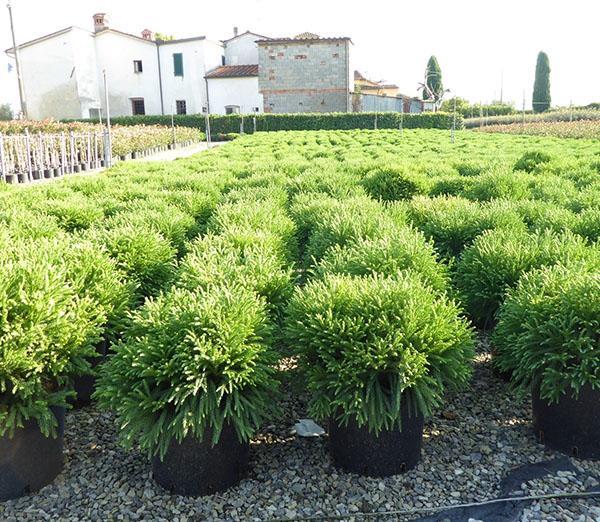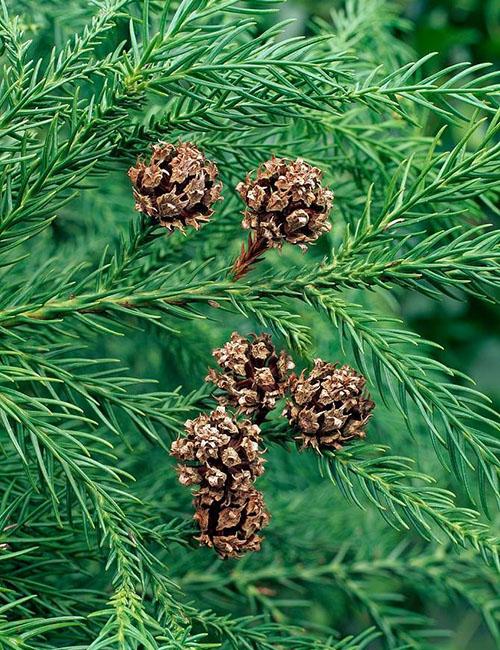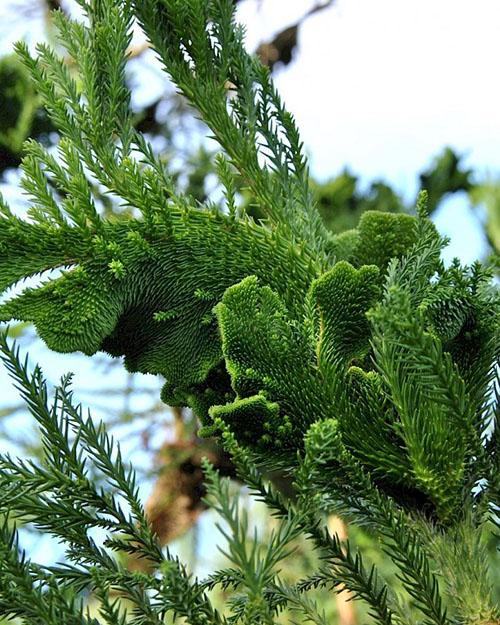Spectacular ephedra Cryptomeria or Japanese cedar
 Many ornamental plants that adorn streets and homes come from the most remote corners of the world. Japanese cedar, officially called Cryptomeria or Cryptomeria japonica, is found naturally in the Land of the Rising Sun. It is difficult to imagine that the 50-meter giants growing on the mountain slopes, recognized as a national symbol in their homeland, will be known in the world as a pot plant.
Many ornamental plants that adorn streets and homes come from the most remote corners of the world. Japanese cedar, officially called Cryptomeria or Cryptomeria japonica, is found naturally in the Land of the Rising Sun. It is difficult to imagine that the 50-meter giants growing on the mountain slopes, recognized as a national symbol in their homeland, will be known in the world as a pot plant.
The fact is that the spectacular coniferous culture is thermophilic. In Russia, under the open sky, it can survive only in the Black Sea subtropics. At the same time, young plants perfectly tolerate growing in a pot, thanks to the formation and pruning, they retain their compact size for a long time and can take on the most bizarre forms. Therefore, Japanese cryptomeria is highly valued by amateurs bonsai.
Description of Japanese cryptomeria

The plasticity and decorativeness of culture have long attracted lovers of ornamental plants. In Europe, Japanese cedar was first cultivated in 1842.
For fear of cold weather, you can meet an adult tree in the open ground only in the southern regions. And potted specimens of different sizes and shapes are used in gardening design and as green pets.
 Today, several dozen varieties have been bred with bluish, gray-gray and golden needles. Dwarf forms and plants with a naturally spherical crown are available to flower growers and amateur gardeners.
Today, several dozen varieties have been bred with bluish, gray-gray and golden needles. Dwarf forms and plants with a naturally spherical crown are available to flower growers and amateur gardeners.
Conditions for growing Japanese cedar
 At home, cryptomeria is unpretentious and responds to minimal care with good growth and bright greenery.
At home, cryptomeria is unpretentious and responds to minimal care with good growth and bright greenery.
The tree easily tolerates pruning, the shape of the branches and trunk can be gradually changed using bonsai techniques. This allows you to create unique live compositions.
In nature, young trees are under the forest canopy. Therefore, Japanese cryptomeria does not need a special lighting mode and is shade-tolerant enough. The plant tolerates shade well, can grow on north, west and east windows. But on the south side, in direct sunlight, it will look oppressed.
The optimum temperature for mini cedar in summer is 22–25 ºC. For the winter, the pot must be moved to a cool place, while the air in the room should not be colder than +12 ºC.
If the climate permits, the ephedra can be taken out into the garden or on the terrace, not forgetting the shading of the Japanese tree and protection from the cold wind.
 Cryptomeria is hygrophilous, so it is regularly watered, making sure that the soil does not dry out and does not accumulate too much water. Stagnant moisture provokes root rot, disease and plant death. Adult Japanese cedars are given a warm sprinkler or soft water sprinkler during hot and dry periods. If necessary, regulate the humidity in the room, bringing it to a level of 60-80%. The trees are protected from overheating by carefully ventilating the room.
Cryptomeria is hygrophilous, so it is regularly watered, making sure that the soil does not dry out and does not accumulate too much water. Stagnant moisture provokes root rot, disease and plant death. Adult Japanese cedars are given a warm sprinkler or soft water sprinkler during hot and dry periods. If necessary, regulate the humidity in the room, bringing it to a level of 60-80%. The trees are protected from overheating by carefully ventilating the room.
Planting Japanese cedar
 To limit the growth of the tree, a shallow pot with a drainage hole in the bottom is chosen for planting Japanese cedar.It is best to purchase a heavy ceramic container.
To limit the growth of the tree, a shallow pot with a drainage hole in the bottom is chosen for planting Japanese cedar.It is best to purchase a heavy ceramic container.
In this case, the growing ephedra will remain stable for a long time. Cryptomeria is moisture-loving, so that the plant does not experience discomfort, it needs a moisture-consuming, loose soil.
It can be a ready-made substrate for coniferous crops or a soil mixture based on:
- 2 pieces of leafy land;
- 2 parts of turf soil;
- 1 part peat;
- 1 part washed sand.
Drainage from expanded clay is poured onto the bottom of the pot, then a layer of substrate is laid out. The seedling is positioned so that the roots are straightened, and the root collar is at ground level. After backfilling, the soil is compacted, the plant is watered.
 In the future, the cultivation of Japanese cedar consists in maintaining optimal growth conditions for the culture, watering and feeding. It is optimal to use complex formulations specially selected for coniferous crops. The maximum benefit of feeding is brought at the beginning of active growth, that is, from March to June.
In the future, the cultivation of Japanese cedar consists in maintaining optimal growth conditions for the culture, watering and feeding. It is optimal to use complex formulations specially selected for coniferous crops. The maximum benefit of feeding is brought at the beginning of active growth, that is, from March to June.
To limit the growth of the tree, do not get carried away nitrogen fertilizers, especially on the eve of the cold period.
Reproduction of Japanese cedar cryptomeria
 At home, young Japanese cedar plants can be grown using semi-lignified cuttings. They are harvested at the end of summer, when the young shoots are strong and mature enough.
At home, young Japanese cedar plants can be grown using semi-lignified cuttings. They are harvested at the end of summer, when the young shoots are strong and mature enough.
The cut is made a few centimeters below the green part of the branch. The lower needles are carefully removed. After treatment with a root stimulant and crushed activated carbon, the cuttings are added dropwise in a substrate of sand and torus. A greenhouse with seedlings is provided with bottom heating. Japanese cryptomeria is planted in a permanent pot at the age of 1-3 years with a fully formed root system.